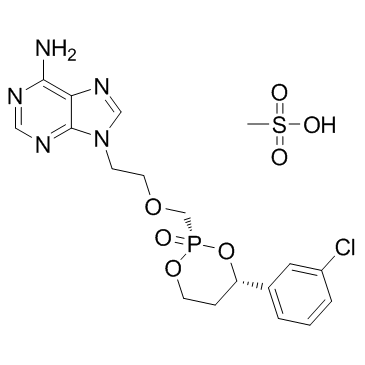| Cas No.: | 625095-61-6 |
| SMILES: | NC1=C2N=CN(CCOC[P@]3(OCC[C@@H](C4=CC=CC(Cl)=C4)O3)=O)C2=NC=N1.CS(=O)(O)=O |
| Formula: | C18H23ClN5O7PS |
| M.Wt: | 519.9 |
| Purity: | >98% |
| Sotrage: | 2 years -20°C Powder, 2 weeks 4°C in DMSO, 6 months -80°C in DMSO |
| Description: | Pradefovir mesylate is a good substrate for liver CYP3A4. Pradefovir is converted to 9-(2-phosphonylmethoxyethyl)adenine (PMEA) in human liver microsomes with a Km of 60 μM. |
| In Vivo: | Daily oral dosing of Pradefovir (300 mg/kg) to rats for 8 days does not affect body weight; liver weight; liver weight-body weight ratio; liver microsomal protein content; total CYP content; enzyme activities for CYP1A, CYP2B, and CYP3A; and apoprotein contents for CYP1A1, CYP2B1/2, CYP3A1/2, and CYP4A1/3, indicating that Pradefovir is not a CYP inducer in rats[1]. |
| In Vitro: | Pradefovir is a cyclodiester prodrug of PMEA. It is one of the HepDirect prodrugs, which are designed to be efficiently and specifically activated through an oxidative reaction catalyzed by CYP3A4, which is located mainly in the liver. Pradefovir is converted to PMEA in human liver microsomes with a Km of 60 μM, a maximum rate of metabolism of 228 pmol/min/mg protein, and an intrinsic clearance of about 359 L/min[1]. |
| Animal Administration: | Rats[1] Five rats receive Pradefovir (300 mg/kg/day) orally for 8 days. At 24 h after administration of the last dose, the rats are killed and liver samples are collected. Body weight, liver weight, liver protein content, and liver microsomal P450 contents are determined. The apoprotein levels for CYP1A1, CYP2B1/2B2, CYP3A1/3A2, and CYP4A1/4A3 and the enzyme activities for CYP1A, CYP2B, and CYP3A are also determined by Western blot and LC analysis, respectively[1]. |
| References: | [1]. Lin CC, et al. Metabolic activation of Pradefovir by CYP3A4 and its potential as an inhibitor or inducer. Antimicrob Agents Chemother. 2006 Sep;50(9):2926-31. |

 To enhance service speed and avoid tariff delays, we've opened a US warehouse. All US orders ship directly from our US facility.
To enhance service speed and avoid tariff delays, we've opened a US warehouse. All US orders ship directly from our US facility.




















